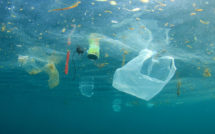

This is part of our Campus Feature on Water Centers & Institutes.
The American West is an arid region to begin with, and climate change, population growth, and aging infrastructure are further exacerbating water scarcity in some parts of the region. Stanford University established Water in the West in 2010 to conduct research relevant to the growing water challenges in the American West and to develop solutions that will move the region toward a more sustainable water future. Water in the West is a joint program of the Stanford Woods Institute for the Environment and the Bill Lane Center for the American West. Water in the West marshals the resources of Stanford University to address one of the most urgent questions about the West’s future—how the region can continue to thrive despite growing water scarcity.
To deal with future water challenges, the West needs new technologies, management practices, institutions, and laws that are more flexible and efficient than our current systems. The overarching mission of Water in the West is to facilitate this shift by engaging a multi-disciplinary team of faculty and researchers from engineering, law, economics, political science, public policy, geophysics, hydrology, and atmospheric sciences in order to bridge the gap between academic research and applied solutions. To accomplish this goal, engagement, communications and strong partnerships are all a central part of the program’s work.
Water in the West seeks to develop solutions through four methods:
- Creating solutions through research in law, policy, management, and technology.
- Engaging Stanford students in creating water management solutions, in order to both address water scarcity today and educate the next generation of leaders.
- Using communications to advance new ideas and share research in ways that are useful for water managers, policy makers and partner organizations. This includes short reports that are easily digestible by non-academic decision-makers, web-based tools, and presentations tailored to water managers, policy-makers, and the public.
- Build strong partnerships with policy makers, water managers, NGOs, and other institutions to inform our research efforts and to provide a direct path for applying research results. Hosting workshops with academic and non-academic experts is a central part of this work, as is collaborating closely with outside partners in research projects.
Although the program’s geographic focus is the American West, its goal is to produce solutions that can be used in other parts of the world, particularly arid and semi-arid regions around the world that are facing increasing water challenges. Water in the West’s work is organized around four primary program areas: sustainable groundwater; watershed health; urban water policy, innovation, and finance; and water and energy.
Sustainable Groundwater
Throughout the West, cities and irrigators are pumping groundwater at unsustainable levels, jeopardizing the primary water supply for many communities and diminishing availability of groundwater as a buffer during times of drought and surface water shortages. Water in the West has conducted interdisciplinary research exploring a variety of aspects of groundwater management, including law, governance, data availability and sharing, and geophysics. Most of this work has been focused on California, and in particular on efforts to implement California’s first law requiring sustainable management of the state’s aquifers (the Sustainable Groundwater Management Act (SGMA), passed in 2014). Recent projects in this area have included a study of local agencies organized to implement SGMA, (Conrad, et al., 2018), an analysis of recent groundwater adjudications in California and their impact on SGMA implementation (Szeptycki, et al., 2018), a value of information analysis of different methods for collecting data about subsidence, a survey of water management agencies with respect to the adequacy of available groundwater data (Moran, et al., 2016), and collaborations with water agencies to explore new geophysical methods for collecting data about groundwater basins (Knight, et al., 2018).
Watershed Health and Allocation
People have heavily manipulated the rivers of the West, first to sustain settlement and agriculture, and then to meet economic and population growth. Dams, water withdrawals, degraded physical habitat, pollution, and other factors have altered western watersheds and profoundly harmed their ecological health. Water in the West focuses on policies and other tools to preserve rivers and streams while not compromising water supplies for cities, farms, and ranches. Recently, the program’s work has centered on two areas. One has been analyzing tools for voluntarily allocating and transferring water for stream flows and other environmental uses under the prior appropriation system of water rights. Work in this area has included research into laws and policies in the Colorado River Basin and their impacts on environmental water transaction activity (Szeptycki, et al., 2017). The second has been developing models and decision support tools for assessing and optimizing changes in agricultural land use to reduce water demand and achieve other benefits, including wildlife habitat and carbon sequestration. Most of this work is furthered by a partnership between Water in the West and the Natural Capital Project, another program of the Stanford Woods Institute. Recent projects have included efforts to model the potential hydrologic impacts of changes in cattle grazing practices and a separate study aimed at modeling the hydrologic benefits produced by forest restoration practices designed to reduce fire intensity. This research team is now shifting to study tools for optimizing the benefits, and minimizing the negative impacts, of potential agricultural land use changes in California’s Central Valley driven by increased water scarcity.
Urban Water Policy, Innovation, and Finance
Urban water faces unique challenges that will only become more complicated with population growth, climate change, and environmental and water quality concerns. Efficient management is hampered by lack of and access to data, fragmented governance, aging infrastructure, and antiquated financial and management schemes. A joint program between Water in the West and Reinventing the Nation’s Urban Water Infrastructure, an NSF funded research consortium, explores all of these issues, and is developing policy, finance, and management tools with the potential to transform urban water management and infrastructure. Recent projects have included research into the rate of innovation in the water sector (Ajami et al., 2014), developing new tools to finance evolving water infrastructure (Quesnel, et al. 2018), a study of new performance metrics for assessing multi-benefits associated with green infrastructure (Gordon, et al. 2018), development of a system for trading urban water conservation credits and virtual water among Bay Area water utilities (Gonzales, et al., 2017), research into patterns of water conservation (and water use rebound) during and after droughts (Gonzales and Ajami, 2017a), development of regional systems for urban water supply resilience (Gonzales and Ajami, 2017b), and studies of new tools for predicting urban water demand (Quesnel and Ajami, 2017
Water and Energy
Water and energy use are strongly linked, since withdrawing, transporting, and treating water require large amounts of energy. Energy production and extraction can also use large amounts of water. Despite these interdependencies, energy and water are managed separately.
Water in the West has brought water scholars together with experts at Stanford on energy production and efficiency to explore new tools to better integrate water and energy management and to find ways to increase efficiency on both fronts (Ajami and Truelove, 2014). The team brings together a range of disciplines, including engineering, hydrology and water resources, and social sciences. Recent projects in this area include an interdisciplinary study of water and energy in the Baja California border region, a life cycle assessment of cross-border electricity supply chains between California and Mexico (Bolorinos, et al. 2018), and a study of opportunities for in-conduit generation of hydropower in water distribution systems (Ayu, et al. 2018).
The program actively seeks new partners to expand its horizons and collaborate on emerging water challenges around the world and more specifically in arid and semi-arid regions.
Leon Szeptycki, JD, is executive director of Water in the West and Professor of the Practice at the Stanford Woods Institute for the Environment. He is an expert in water law and policy, with a focus on restoration of rivers and watersheds.
Newsha Ajami, PhD, is the director of Urban Water Policy a joint effort among Stanford University’s Water in the West program, Bill Lane Center for American West, and NSF’s ReNUWIt initiative. She is a leading expert in sustainable water resource management, water policy, innovation, and finance, and the water-energy-food nexus.
Learn more about Water in the West here.
References:
Ajami, N.K., Truelove, C., 2014. “A Water-Energy Research Agenda: Building California’s Policy Foundation for the 21st Century”. (Stanford Woods Institute for the Environment, 2014).
Ayu Sari, M., Badruzzman, M., Cherchi, C., Swindle, M., Ajami, N., Jacangelo, J.G. 2018. “Recent Innovations and Trends in In-Conduit Hydropower Technologies and their Recent Applications in Water Distribution.” Journal of Environmental Management. 228; 416-23.
Bolorinos, J., Ajami, N., Muñoz Meléndez, G., and Jackson, R. 2018. “Evaluation Environmental Governance along Cross-Border Electricity Supply Chains with Policy-Informed Life Cycle Assessment: The California-Mexico Energy Exchange.” Environmental Science and Technology. 52(9); 5048–5061.
Conrad, E., Moran, T., DuPraw, M.E., Ceppos, D., Martinez, J., and Blomquist, W. 2018. “Diverse Stakeholders Create Collaborative, Multilevel Basin Governance for Groundwater Sustainability.” California Agriculture 72(1); 44-53.
Gonzales, P., and Ajami, N.K. 2017a. “Social and Structural Patterns of Drought Related Water Conservation and Rebound.” Water Resources Research. 53(12); 10619-10634.
Gonzales, P., and Ajami, N.K. 2017b. “An Integrative Regional Resilience Framework for the Changing Urban Water Paradigm.” Sustainable Cities and Societies, 30, 128-138.
Gonzales, P., Ajami, N.K., Sun, Y., 2017. “Coordinating Water Conservation Efforts Through Tradable Credits: A Proof of Concept for Drought Response in the California Bay Area.” Water Resources Research. 53, doi:10.1002/2017WR020636.
Gordon, B., Quesnel, K.J., Abs, R., Ajami, N. 2018. “A Case-Study Based Framework for Assessing the Multi-Sector Performance of Green Infrastructure.” Journal of Environmental Management. 223; 371-384.
Knight, R., Smith, R., Asch, T., Abraham, J., Cannia, J., Viezzoli, A., Fogg, G. 2018. “Mapping aquifer systems with airborne electromagnetics in the Central Valley of California.” Groundwater, 56 (6); 893-908.
Moran, T., From the Ground Down: Understanding Local Groundwater Data Collection and Sharing Practices in California (Stanford Woods Institute for the Environment, 2018).
Quesnel, K.J., and Ajami, N.K. 2018, “Advancing Water Innovation Through Public Benefit Funds: Examining California’s Approach for Electricity.” Journal of the American Water Works Association. 110(2); E18-32.
Quesnel, K.*, N.K. Ajami, 2017. “Evaluation Of Residential Water Use Behavior Changes Linked to Heightened News Media Coverage of Drought”, ScienceAdvances, 3(10),
doi:10.1126/sciadv.1700784.
Szeptycki, L., Conrad, E., Blomquist, W., and Martinez, J. 2018. “A Flexible Framework or Rigid Doctrine? Assessing the Legacy of the 2000 Mojave Decision for Resolving Disputes Over Groundwater in California.” Stanford Environmental Law Review, 37(2); 185-250.
Szeptycki, L., and D. Pilz. The Colorado River Basin Environmental Water Transfers Scorecard (Stanford Woods Institute 2017).
Photo: Fresh blue fountain water | Shutterstock
Published on December 11, 2018.




